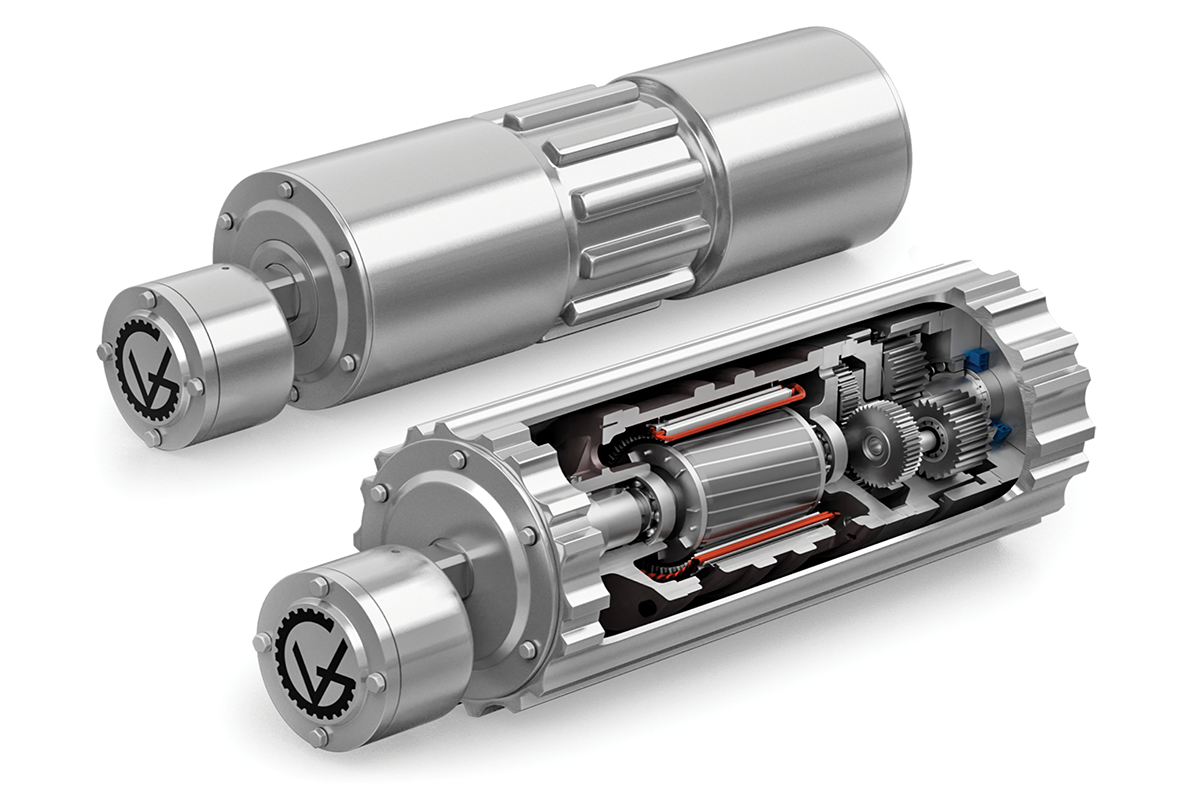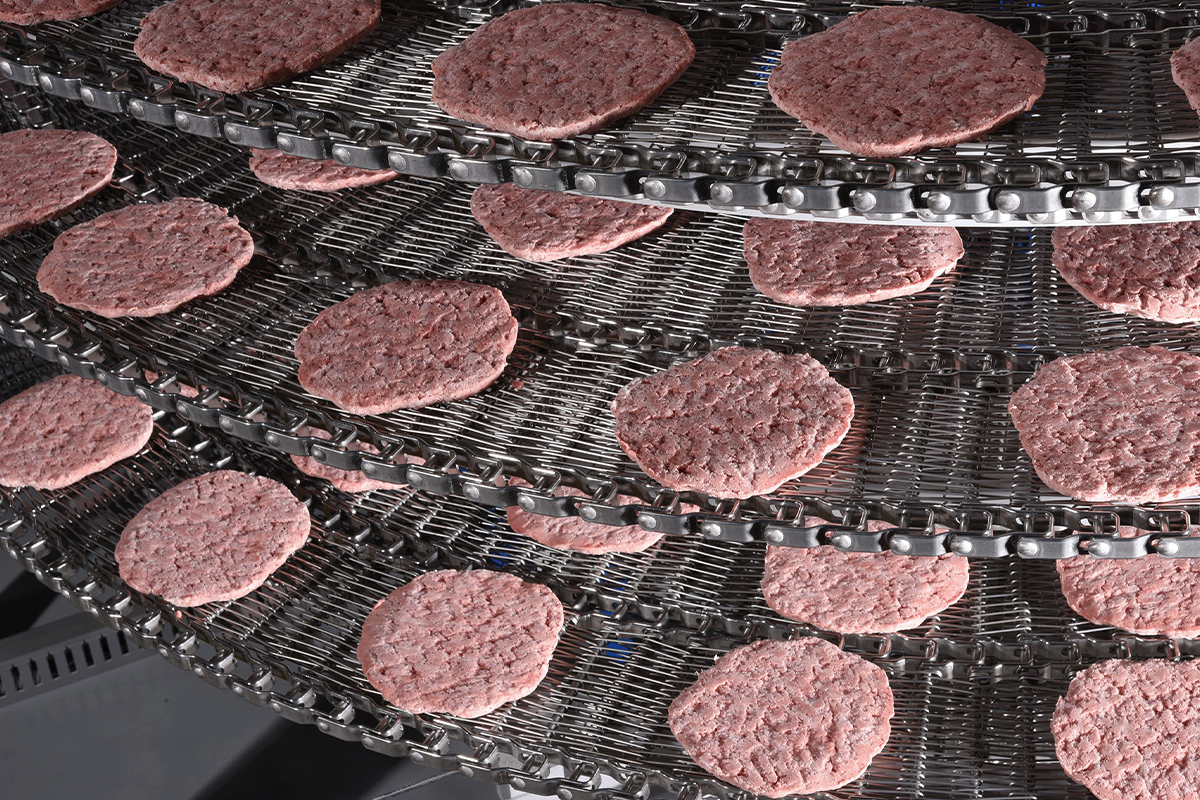Moving meat and poultry through the processing line is an integral piece to the operation of preparing food. The conveyance of products through plants requires many standards to get from a live animal down to the consumer. Meat and poultry processors deal with many issues at the plant and prefer equipment that runs smoothly, efficiently and provides service with a minimal amount of attention.
All equipment in the industry needs maintenance, sanitation, parts replacement, etc. It is the nature of machinery, but if suppliers can minimize those needs without decreasing throughput and efficiency, the entire food supply chain reaps the rewards of quality and quantity in production.
Safe and efficient
Food safety always sits atop the priority list for food processors because without it, the endeavor is futile. Conveyor systems and the drum motors that power them must be hygienic and prevent contamination at all costs. Processors ensure the equipment they use must come from suppliers who understand this and make it a part of their food safety culture and manufacturing.
“The most common requests from processors are for things that meet strict industry hygiene standards, such as cleanability, resistance to harsh chemicals, HACCP compliance, and the ability to clean-in-place (CIP),” said Pablo Ruiz, head of Product Management at Bauer Gear Motor, Charlotte, NC, a Regal Rexnord company. Regal Rexnord, Milwaukee, Wis., manufactures electric motors and power transmission components serving many industries including the meat and food processing industries.
Companies that design conveyance equipment take this into consideration when engineering machines, but another factor they consider is efficiency and maximization of output. If time of cleaning and sanitization dips into production time and gets out of balance, a producer could essentially suffer losses.
“You’re making money when you’re producing. So, when you go into your sanitation cycles, you want to clean it quickly, fast and effectively,” said Jonathan Lasecki, director of engineering at Ashworth Brothers Inc., Winchester, Va. “So, we’ve designed a lot of products to allow for that. Our Omni-Pro and Omni-Grid 360 belts have very hygienic welds that have smooth surfaces. So, we design predominantly to help sanitation and cleanability in the systems that go out into the field.”
Kevin Guernsey, food team engineering supervisor at New Orleans, La.-based Intralox said the ideal conveyance system follows the construction standards of the updated North American Meat Institute’s Food Safety Equipment Design Principles.
“The principles address the two major pillars of food safety (hygiene/sanitation and foreign material prevention). We are seeing more emphasis these days put on elements to prevent the system from generating foreign material into the product stream.”
But the responsibility does not fall solely on the original equipment manufacturer (OEM). Processors must, through solid partnerships with their suppliers, follow diligent best practices in set up, cleaning and preventative maintenance for their machines and belts.
“Proper sprocket alignment, the right amount of tension on the belt, not overloading the belt based on the OEM’s recommended loading weight, and purchasing back up parts and replacing these parts when they are worn down are some examples of how you can maximize productivity and minimize downtime,” said Jeff Fontaine, product manager, Wirebelt Co. of America located in Bedford, NH.
Building the system
Processors rely on the entire conveyance system at all stages of production. Slaughter facilities sending primals to further processing need different systems than a further processing facility that transports packaged products to retailers, distributors or foodservice customers. But no matter the product or process, there are some things all solid conveyance systems require.
A conveyance system starts with a high-quality stainless-steel frame with seamless welds and little to no hardware, stainless steel drive motors/gearboxes and conveyor belt components. The conveyor belt components must be sized appropriately and there must be enough of them for proper support.
“Gravitating toward smaller sizes and minimal support components may look like a way to cut costs, but in the end create a poor performing system that can cause downtime or other issues,” Guernsey said.
The system must also have a conveyor belt. Companies must purchase a belt made of materials that will withstand the rigors of the processing environment including chemical exposure during processing and sanitation.
“With plastic, if you’re cutting or nicking, you may put scratches on that belt, which was smooth,” Lasecki said. “Now it has little crevices that could harbor the things we don’t want to be there. So, you may not find plastic on cutting lines, where metal may be more prevalent because of its resistance to that. Of course, metal has some drawbacks if you get metal wear, or it might make it metal shavings.”
 Enclosed drive components on drum motors offer hygiene and efficiency advantages. (Source: Van der Graaf Corp.)
Enclosed drive components on drum motors offer hygiene and efficiency advantages. (Source: Van der Graaf Corp.)Making it move
Like other processes in meat packing, processor concerns involving the motors that run their conveyors tend to revolve around efficiency, reliability, longevity, sanitation, and how it stands up to washdown cycles during the sanitization routine.
“Maintenance and operational costs are also a major concern now with more pressure on processors to reduce operational costs and increase uptime,” said Alex Kanaris, president of Van der Graaf Corp., Shelby Township, Mich.
Conveyor motors have gone through a few changes over the years. Permanent magnet motors, high-efficiency motors and the elimination of motor housings have all become go-to variations. Regal Rexnord’s Bauer Gear Motor offers the Hiflex Drive stainless steel series. Developed as an improvement to the AsepticDrive series, it reduces potential contamination from wear in the coating while the stainless steel holds up to harsh mechanical conditions and meat packing environments.
“This improves food safety and eliminates germs from being blown through the air if some food particles or contaminants have inadvertently fallen into the motor area,” Czerniak said.
Kanaris said, “Utilization of drum motors in processing facilities is the most recent trend we’ve observed.”
Drum style motors offer hygienic and efficiency advantages. The SSV series drum motor from Van der Graaf has the belt profile machined directly onto a stainless steel drum where all drive components are enclosed and protected inside the drum. It drives modular conveyor belts without using sprockets, eliminating gaps, crevices, and bacterial harborage areas.
Drive motor companies and conveyor belt companies do collaborate to ensure their customers get the best solution to their conveyor needs. The collaboration allows for good combinations that serve the industry, as well as the individual processor.
“We don’t generally do motors as a standard offering,” said Bryan Hobbs, service director for Ashworth factory service. “We do work with a lot of those organizations to try and make sure that we’re pairing properly to what their offerings are.”
Always automation
Automation is still at the forefront of advancement in the meatpacking industry. Suppliers of conveyors and the motors that drive them have begun to see their systems become more technically advanced and automated as the industry moves forward.
Motor manufacturers and conveyor belt manufacturers have both started integrating new automation and technology into their products. It has become necessary for conveyor and motor companies to develop technologies that communicate with a processing plant’s central control system allowing the regulation of belt speeds for better production flow and improved throughput. Also, electric motors now use frequency inverters to drive conveyors.
“The frequency inverter is part of a programmable logic controller system that regulates and streamlines production,” Kanaris added.
Ashworth developed a system into “smart” ovens and other smart equipment. The Smart Spiral hooks into existing equipment and monitors trends over time such as tension or temperature and send data, or warnings, back to the end user through a tablet, laptop or mobile phone. The technology provides processors an estimation of the lifecycle of the equipment as well.



